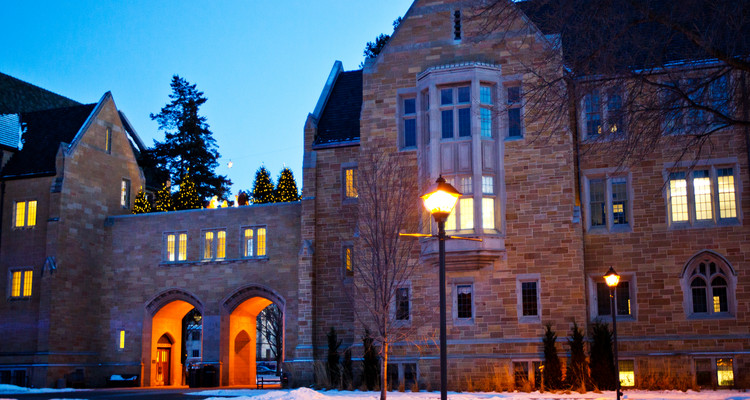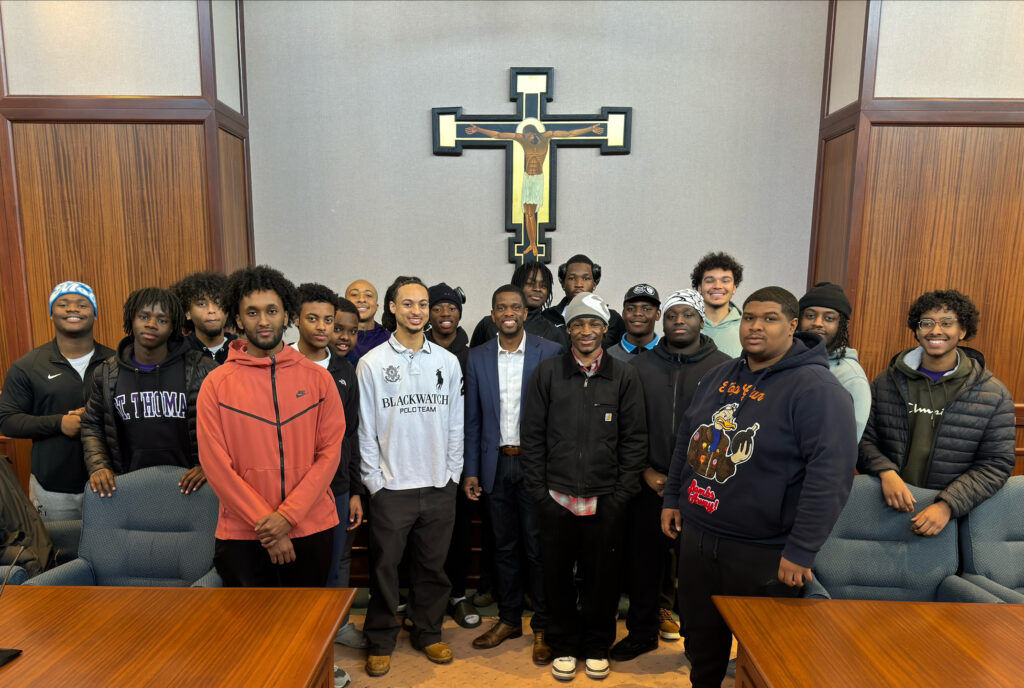If St. Thomas January Term could talk as it approaches the over-the-hill marker of 40 years old, it very well might draw from Rodney Dangerfield, tie askew, handkerchief in hand, lamenting, “I get no respect.” Like a bad printer or vacuum deal, January classes at St. Thomas are a “two-for-one-special” kind of Tommie Tradition: You get the tradition itself of January Term at St. Thomas. And then you get the tradition of talking about whether January Term at St. Thomas should be a tradition.
January Term – “J-Term” to everyone but the course catalog – has been in the curriculum since the 1975-76 school year. Kind of. It started out known as “January Interim.”
Regardless of its title, it always has been accompanied by conversation of whether it should be kept, tweaked or ditched altogether in favor of a different academic model. That healthy, longstanding debate has prompted several changes throughout the decades. It also has laid the framework for more examinations at St. Thomas as a new strategic plan is put in place.
"Educational experimentation"
Like many traditions, J-Term can trace its roots back to the 1960s. Or at least ideas from the 1960s. January Interim became somewhat common in higher education throughout the 1960s and 1970s: “Students may take any interim course offered on the St. Thomas campus, any course on the other campuses in the five college cooperative association (i.e., Augsburg, Hamline, Macalester, and St. Catherine) or an interim course at selected other colleges around the nation,” read the 1975-76 St. Thomas course catalog.
“That was a period of educational experimentation in this country, the 1960s and 1970s,” said Michael Jordan, current associate vice president of undergraduate studies and academic advisement. “We offered innovative courses that were not part of the regular curriculum. Faculty would develop various courses that gave students the chance to explore different aspects of a subject or the world that weren't necessarily covered (in traditional classes).”
Non-credit, free classes were offered on everything from canoe building to meteorological education focused on the cold, with undergrads required to complete two courses before they graduated (transfers only needed one and special projects could qualify as substitutes). Even with those flexibilities, early on, January Interim had documented struggles capturing its target audience: “Despite topics covering birth, death and just about all the other games people play in between, many students say the courses offered don't appeal to them,” a February 1980 The Aquin article said.
Santa delivers change
Other schools dealt with similar feedback, prompting many – including St. Catherine in 1983 – to drop their interim offerings altogether. In that same year, according to The Aquin, St. Thomas tasked a subcommittee with taking a comprehensive look at how the school should handle its winter-month future. Those pointed discussions led to a major overhaul in 1985, prompting the headline, “Faculty vote in new January Term” in a Dec. 13 The Aquin article, which featured the drawing of a faculty member dressed as Santa presenting a wrapped box labeled “January Term” to a happy-to-accept student body.
In reality, the name swap was just the beginning; the biggest change from the 90-68 faculty vote was the move to credited classes in January, either full-credit courses (48 hours) or half-credit courses (24 hours) over four weeks. This also meant a new graduation requirement of 33 courses (132 credits), up from 32 (128).
Not everything changed, though: These new classes would still be free, and students were allowed to take a full-credit or two half-credit classes each January term.
“Students need not come during January, if they choose not to,” then-academic dean John Nemo told The Aquin at the time. “We hope some will because the one course or two half-courses will be free.”
Another makeover, revitalization
As one with the clarity of retrospect might think, students were more than willing to come during January for free credited classes. It took just three years before academic affairs determined the J-Term classes should require payment like normal courses, according to The Aquin.
That decision far from set J-Term’s status at St. Thomas in stone, however. In 1989 the ACTC schools gathered to discuss changing their academic model entirely, considering options that included keeping the current system; going to a different 4-1-4 (J-Term as an open period with no classes); two 14-week semesters (no J-Term); two 15-week semesters (no J-Term); or a 4-4-1 (a four-week class period in May). Summing up the need for the conversations, Nemo said, “The novelty of J-Term may have simply worn off.”
Much like Mark Twain’s famous quip, reports of J-Term’s death at that point proved to be an exaggeration. A February 1990 Aquin headline stated, “Students satisfied with J-Term setup,” and highlighted the start of a decade that saw several reports of increasing enrollment in courses, especially to study abroad. Those stories also timed with St. Benedict’s and St. John’s dropping J-Term in 2001, leaving St. Thomas – along with Hamline – as one of just four Minnesota institutions to keep its January Term.
Continued discussion
More recently, a 2005 curriculum task force at St. Thomas again revisited the overall presence of J-Term. Jordan, a member of that committee, said – then and now – the perceived positives (study abroad popularity, a chance for students to work outside of school, volunteer on VISION trips, take an extended break to travel or recharge between semesters, etc.) always coincide with perceived negatives (not enough offerings for all students, large parts of the student body disengaged from the school for too long, etc.).
“It's been difficult to reach consensus,” Jordan said.
That, more than anything else, may be the best way to describe the tradition of J-Term and J-Interim at St. Thomas. For many it has contained some of the fondest memories of interaction with their school, whether in a trip abroad or in a particularly engaged, condensed course on campus. For others it has contained seemingly never-ending days and weeks away from school in the heart of another Midwest winter.
With a strategic plan in place and another examination of the overall curriculum coming with it, J-Term will likely soon get another close look, Jordan said. The tradition of debating the tradition will log another chapter and, perhaps, bring about more changes.
Or not. Some say 50 is the new 40, anyway. J-Term may very well be around to find out if it can reach that birthday.







